


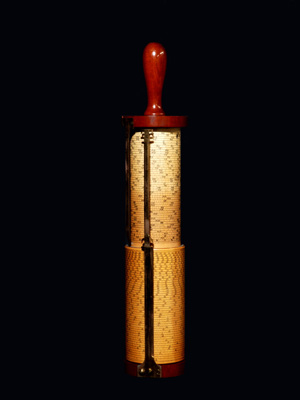
円筒形計算尺
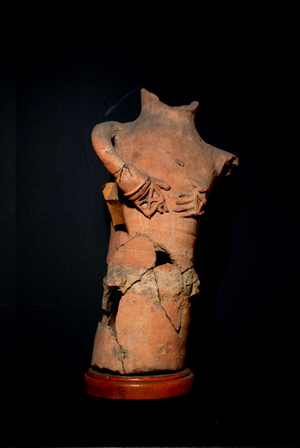
古墳時代の埴輪
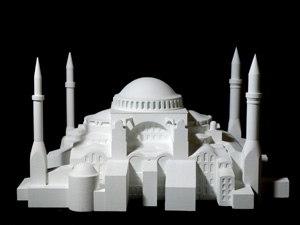
ハギア・ソフィア模型
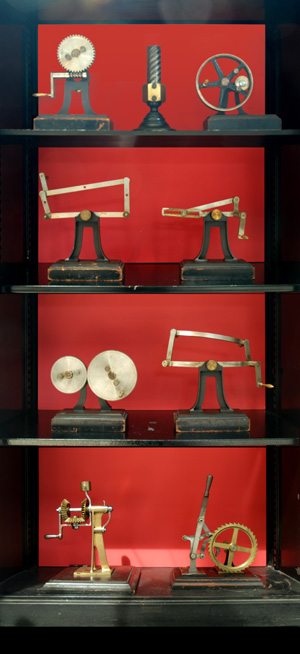
機械機構模型
 展示標本 (2009.8.3〜2010.1.31)
展示標本 (2009.8.3〜2010.1.31)小ケース1: 円筒形計算尺
log(a×b)=log(a)+log(b)という対数法則に基づく計算尺の一種。らせん状に配されたスケールに対して2つの指示器を相互に自由に動かすことができ、なおかつ両者の関係を保持したまま動かすことができるように3つの円柱が入れ子状に連接されているもので、モデルによって本品のようにsin尺やlog尺なども備えている。1878年にジョージ・フラー教授(クイーンズ・カレッジ、ベルファスト)によって考案され英国スタンレー社によって製造された。
Cylindrical Spiral Slide Rule
Logarithmic slide rule with cylindrical spiral scale and two pointers moved freely and simultaneously by the composition of three cylinders, which is a model with scales of sines and logs. Such slide rule was designed by George Fuller (Professor of Engineering, Queen's College at Belfast) in 1878 and manufactured in England by Stanley.
小ケース2: 古墳時代の埴輪
日本の古代ならびに先史の学術研究は東京大学の創立後まもなく始まった。1880年代には人類学の分野が確立し、いわゆる「石器時代」と「古墳時代」の調査が活発に行われた。学術標本としての遺物が多数収集され、大正期には、理学部人類学教室の古写真集に、現在重要文化財指定を受けている2点を含む、40点の埴輪が掲載された。ここに展示した埴輪は、出土地不明のものであるが、同じ時代に収集されたものと思われる。
標本番号A842「埴輪・人(頭なし)」
Burial mound figurine
Research into Japan's prehistory started early upon establishment of the University of Tokyo. Since the 1880s, both the "stone age" and the "tumulus period" were investigated with vigor. Artifacts were collected and accumulated for scientific investigations. In the Taisho period (1912-1925), the University of Tokyo's Anthropological Institute published a photographic documentation of 40 "haniwa" (or burial figurine) specimens, including two of which have since been designated Japan's "Important Cultural Properties." The haniwa exhibited here belongs to the same traditional collections, now housed at the University Museum, the University of Tokyo.
Specimen number A842 「haniwa, anthropomorph (lacking head)」
小ケース3: ハギア・ソフィア模型
東ローマ帝国のユスティニアヌス帝によって532年から537年にコンスタンティノポリス(イスタンブル)につくられたビザンティン様式の教会堂の模型。長方形のバシリカの上に半球形のドームを載せた円蓋バシリカ形式の建築である。地震による何度かのドーム崩落を経て、現在の頑強な形式に補強修正された。直径31Mの大ドームを両側の半ドームが支持することで、中央に向けて高くなる壮大な空間が形成される。オスマン帝国の時代にモスク(アヤ・ソフィア)に転用され、4本のミナレットが建てられた。
(縮尺1/300、スタイロフォームにジェッソ、横塚和則制作、2008)
Model of the Hagia Sophia
This is a model of the Byzantine style cathedral constructed between 532 and 537 at Constantinople (Istanbul) by Emperor Justinian of the Eastern Roman Empire. The building is made in a Dome-Basilica style that has hemispherical domes on top of a rectangular basilica . Domes collapsed several times due to earthquakes, and had been repaired and reinforced in more robust conditions. The magnificent interior space has a higher volume in the center where the main dome of 31M diameter supported by two semi-domes on both sides. In the Ottoman Empire, Hagia Sophia had been converted to the Ayasofya Mosque, and four minarets were built. (1/300 scale, gesso on styrofoam, Kazunori Yokotsuka, 2008)
中ケース: 機械機構模型
さまざまな要素を介した動力伝達の仕組みがわかりやすく表現された模型。明治初頭から機械工学の教育に使われてきた。ねじ機構、てこ・クランクやスライダなどからなるリンク機構、歯車機構などいずれも基本的な内容のものである。
Mechanical Models
Models for showing the mechanism of the transmission of force and movement by the composition of mechanical elements, which were used in the education of mechanical engineering since the early Meiji era. These models are showing fundamental mechanism such as screw mechanism, linkage mechanism, composition of lever, crank and slider, and gear mechanism.
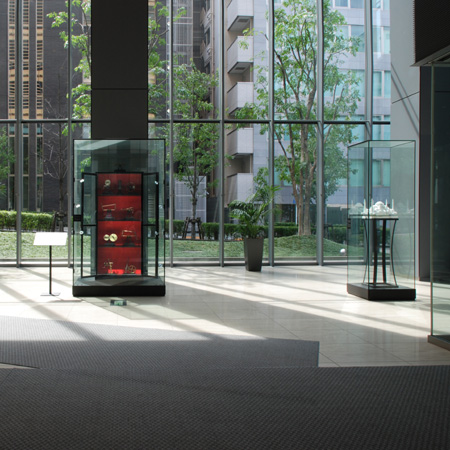
赤坂インターシティのエントランスロビーに設営されたモバイルミュージアム
解説文執筆
諏訪 元 (本館教授、形態人類学) Gen Suwa (Professor)
藤尾 直史 (本館助教、建築史学) Tadashi Fujio (Assistant professor)
松本 文夫 (本館特任准教授、建築・情報デザイン) Fumio Matsumoto
(Affiliate associate professor)
写真撮影
松本 文夫 (本館特任准教授) Fumio Matsumoto (Affiliate associate professor)
展示期間別の標本解説
2007年1月〜2007年7月
2007年7月〜2008年2月
2008年2月〜2008年8月
2008年8月〜2009年2月
2009年2月〜2009年7月
2009年8月〜2010年1月
2010年2月〜2010年7月
2010年8月〜2011年1月
2011年1月〜2011年7月
2011年8月〜2012年1月
2012年1月〜2012年7月
2012年8月〜2013年2月
2013年2月〜2013年8月
2013年8月〜2014年1月
2014年2月〜2014年11月
2014年11月〜2015年7月
2015年8月〜2016年1月
2016年2月〜2016年7月
今までのトップページの連続スライドショー
興和不動産本社におけるモバイルミュージアム(非公開)
ページの先頭に戻る